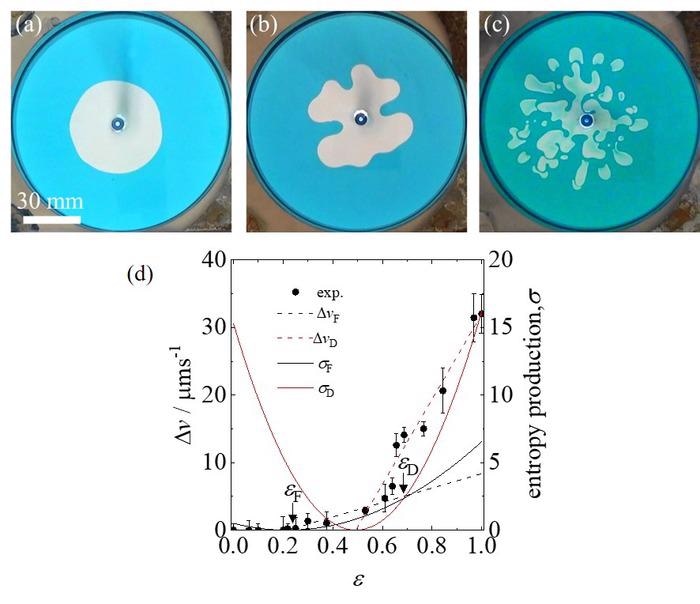The Tokyo University of Agriculture and Technology (TUAT) in association with Osaka University has proposed a novel approach for tuning hydrodynamics interfacial instability through a thermodynamic parameter to facilitate control over liquid-liquid phase separation.
 Figure: (a) ~ (c) Change in the pattern of the flow interface when the non-equilibrium degree ε is changed at t = 600 seconds. (a) Circular pattern (ε = 0.20). (b) Fingering pattern (ε = 0.61) (c) droplet pattern (ε = 0.97). (d) Calculated entropy production curves during the formation of the circular (C), finger (F, black solid curve), and droplet (D, red solid curve) patterns. The associated velocities are shown as dashed lines. The two intersections among the three entropy production curves appear at ε_F = 0.217 and ε_D = 0.685. Image Credit: Yuichiro Nagatsu/TUAT, Takahiko Ban/ Osaka University.
Figure: (a) ~ (c) Change in the pattern of the flow interface when the non-equilibrium degree ε is changed at t = 600 seconds. (a) Circular pattern (ε = 0.20). (b) Fingering pattern (ε = 0.61) (c) droplet pattern (ε = 0.97). (d) Calculated entropy production curves during the formation of the circular (C), finger (F, black solid curve), and droplet (D, red solid curve) patterns. The associated velocities are shown as dashed lines. The two intersections among the three entropy production curves appear at ε_F = 0.217 and ε_D = 0.685. Image Credit: Yuichiro Nagatsu/TUAT, Takahiko Ban/ Osaka University.
The team successfully predicted the pattern changes of the growing interface with the help of the maximum entropy production principle. The study was published in The Journal of Physical Chemistry B on June 29th, 2021.
Flow at the interface of a fluid is very common. Recently, scientists have been more attracted to the flow of fluid interfaces when accompanied by a physiochemical effect, such as chemical reaction phase changes and phase separations.
Since it includes both physicochemical and hydrodynamic factors, its control and prediction become more difficult than that when the physicochemical factors are not considered. Therefore, we decided to establish an appropriate control and prediction methods for the flow interface when physicochemical effects are involved.
Dr. Nagatsu, Study Corresponding Author and Associate Professor, Department of Chemical Engineering, Tokyo University of Agriculture and Technology
According to Dr. Ban, one of the corresponding authors of the paper and Associate Professor in the Department of Chemical Engineering at Osaka University, “In the equilibrium system, the ‘principle of increase of entropy’ known as the second law of thermodynamics holds. In contrast, the theory of non-equilibrium systems was proposed in the 1950s that the entropy production rate is maximized in a complex system in which two or more irreversible processes interfere.”
However, this principle was demonstrated only in a very limited complex process. For example, crystal growth pattern formation and thermal convection pattern formation. Hence, testing in other complex processes is needed
Dr. Ban, Study Corresponding Author, and Associate Professor, Department of Chemical Engineering, Osaka University
Post experimentation, the researchers reported on the hydrodynamic interfacial instability, which is under the control of a thermodynamic parameter deriving the liquid-liquid phase separation during fluid displacement in a Hele-Shaw cell. This cell comprises two closely spaced plane-parallel plates.
Even during a hydrodynamic stable situation, the instability remains. Adjusting the salt concentration establishes control over the miscibility of the solutions and alters the pattern of the interface. The researchers tracked stable circular, fingering and droplet formation patterns as the salt concentration decreased from the equilibrium.
Our team analyzed this interfacial instability using thermodynamic flux, which is determined from the growth rate of the interface. We also provided a theoretical framework to determine the different patterns such as gas, liquid, and solid phases in equilibrium and to quantitatively predict the transition points between the patterns. Interestingly we found that the pattern transition can be explained by higher entropy production.
Dr. Ban, Study Corresponding Author, and Associate Professor, Department of Chemical Engineering, Osaka University
Dr. Nagatsu concluded, “This result showed that the degree of non-equilibrium plays a decisive role in the interfacial flow with liquid-liquid phase separation. This provides an important guideline for the effective control of interfacial flow with liquid-liquid phase separation. In addition, this result provides a new example in which the principle of maximum entropy production, whose verification has been limited so far, can be applied. In the future, further research on the maximum entropy production principle is required.”
Journal Reference:
Suzuki, R. X., et al. (2021) Tunable Hydrodynamic Interfacial Instability by Controlling a Thermodynamic Parameter of Liquid–Liquid Phase Separation. The Journal of Physical Chemistry B. doi.org/10.1021/acs.jpcb.1c01335.